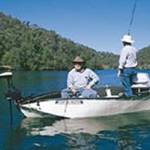Practical Sailor
-

Volume 24 · Number 21
FOLDING PORTA-BOTE FIELD TESTAn Alternative to Inflatables and RIBs………….
Porta-Bote is a fast, unique, folding dinghy for people who “like” inflatables.
Once upon a time, tenders were essentially wooden or fiberglass rowboats. Then came inflatables, which are easier to stow, less likely to damage the boat they are tending, and more stable. True, inflatables are not a joy to row, but boat owners in this country have never been too fond of rowing, anyway. When manufacturers noticed that many people didn’t deflate their inflatables, opting to stow or tow them, and that the lowly tender could be used as a runabout, the RIB (Rigid Inflatable Boat) was developed with a fiberglass bottom surrounded by inflatable tubes. RIBs retain some of the disadvantages of inflatables. They’re not as rugged as a rigid dinghy and they will eventually deteriorate if subjected to long-term ultra-violet (LTV) exposure. They generally provide poor stowage. Their basic configuration wastes interior space – the side tubes intrude into the cockpit so that usable space is limited. And it’s very difficult to add things like cleats; with inflatables – any type you have to buy rubber cleats and fittings and glue them on.
What And How We TestedPorta-Bote, a design concept that’s been around for the past quarter-century (over 50,000 in use, worldwide), provides a good measure of stowability in a boat that’s fast and roomy. It’s made of polypropylene, with polypropylene hinges that allow it to be folded to the size of a large surfboard. We ran Porta-Bote through pretty much the same range of tests that we used in testing stowable inflatables. We noted things such as ease of assembly, time to assemble (in the case of the Porta-Bote), and quality of workmanship.We tested a 10′ Porta-Bote with a 4-hp. Suzuki. We set up the same acceleration course we had used for inflatables. We laid out a string of floats on 50′ centers, and measured the time it took to pass each float with two people aboard. We then took the boat out into open water and measured top speed. Lastly, we just ran Porta-Bote through a series of turns, tight and otherwise, headed for whatever chop we could find (including some fairly serious boat wakes), and generally had some fun.
The first Porta-Bote we ever saw was a double-ended skiff that
was described to us as “sea-going origami.” That was a long time ago; more recently, Porta-Bote replaced the double ender with a square-back model that makes much more sense with an outboard. This series of boats comes in four sizes- 8′, 10′, 12′ and 14′. We tested the 10′ model.Porta-Botes are made of polypropylene, almost 1/4″ thick. There are three chines running the length of the boat; each of these is actually a hinge. transom. With the seats and transom stiffener removed, you can fold Porta-Bote’s center hinge up and end up with a flat package measuring about 10’10” x 24″x 4″ that weighs in at 68 lbs. The three seats bundle up nicely. The folded boat can be lashed to a rail or stored on or below a deck.
Assembling the Porta-Bote is quick and easy. The entire operation, after a bit of practice, takes about six minutes. All fittings are stainless steel or anodized aluminum. Once you put the Porta-Bote together, you have an open dinghy with a 5′ beam. The seats and gunwales carry enough foam flotation to keep the boat afloat and upright even if swamped.Performance with a 4-hp. engine was, in a word, startling! The boat, even with a 200-pounder and some gear aboard, jumped up onto a plane in less than 50′, with no movement nor other acrobatics required on the part of the driver. With only a driver, we reached a speed of 15.2 knots. As a reference point, the easiest-planing RIB we tested, the Apex A10, could only achieve a partial plane and a top speed of only 9.3 knots, with a 4-hp. motor and a solo driver.
The Porta-Bote has a soft ride, apparently because much of the force of waves hitting the boat is soaked up in the hull’s flexing. It’s a nimble boat, not surprising for a beamy, essentially flat-bottomed craft. What we found surprising was how accurately it steered, exhibiting very little of the skidding on turns that we’d expected. The handling of the Porta-Bote was very good. Accurate turns could be negotiated at speeds that were somewhat above our testers’ confidence levels.Stability is excellent. You can stand almost anywhere in the boat without danger of tipping. Porta-Bote is roomier than a comparably sized inflatable. Unlike an inflatable, the entire interior of the boat is available for loading gear.The Porta-Bote’s polypropylene sides aren’t apt to damage a fiberglass or wood hull, even in a forcible meeting. The Porta-Bote isn’t likely to be damaged either. The hull material, which carries a 10-year limited warranty, is really tough. Hulls are available in pearl white, olive drab, and aluminum colors, which are molded into the plastic so that they can’t come off. The hull requires no maintenance other than washing occasionally..An important advantage of the Porta-Bote over a RIB is its price. A 10′ Porta-Bote costs about half of what you’d expect to pay for a comparably sized RIB. Incidentally, Porta-Bote’s pricing is a refreshing change from the usual industry practice.Bottom Line: Inexpensive, fast, stowable Porta-Bote is a good performing, low-cost alternative to an inflatable or RIB.



